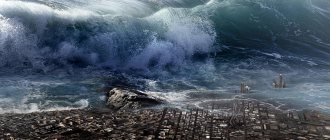Lituya Bay - July 09, 1958
For Alaskans, this date became a bloody page in history. It all started with a magnitude 9 earthquake. Powerful tremors triggered landslides and rockfalls, which led to the collapse of 300 million cubic meters of rock. Lituya Bay was a tempting place for fishermen. That day the weather was calm and sunny, so there were longboats on the water. At about ten o'clock in the evening there was a landslide, which led to the collapse of the rocky mass.
The height from which multi-ton stones fell into the ocean was 910 meters. The waves that rose exceeded 520 meters, and so far this is the highest tsunami. The cozy Lituya Bay was washed off the face of the earth in a matter of seconds. Meanwhile, the highest wave was just picking up speed, which near the shore reached 160 km/h.
The total number of victims is 300 people, and only because there were mainly fishing buildings in the bay. The gigantic pressure of water swept away all the trees and buildings in its path and destroyed the La Gaussi spit. After the cataclysm, huge cracks appeared on the ground.
Alaskan tsunami
An incredible wave formed in 1958 in Lituya Bay, Alaska. The root cause of its occurrence was also an earthquake. But other circumstances were also imposed on him. As a result of the earthquake, a gigantic landslide amounting to about 300 million cubic meters came down from the mountain slopes on the Gulf coast. m of stones and ice. All this collapsed into the waters of the bay, causing the formation of a colossal wave that reached a height of 524 m! Scientist Miller believes that the largest tsunamis in the world occurred there before.
A blow of such force hit the opposite bank that all vegetation and a mass of loose rocks on the slopes were completely demolished, and the rocky base was exposed. The three ships that found themselves in the bay at that unfortunate moment had different fates. One of them sank, the second crashed, but the team managed to escape. And the third ship, finding itself on the crest of a wave, was carried across the spit that separated the bay and thrown into the ocean. It was only by miracle that the sailors did not die. Then they remembered how, during the forced “flight,” they saw the tops of the trees growing on the spit below the ship.
Fortunately, the shores of Lituya Bay are almost deserted, so such an unprecedented wave did not cause any significant harm. The largest tsunami did not cause large casualties. Only 2 people are believed to have died.
Prince William Sound - March 27, 1964
Once again, Alaskans suffered the destructive power of a natural disaster. This time the previous earthquake was estimated at 9.2 points. The force of the underwater shock corresponded to the explosion of 12,000 atomic bombs. Among the territories that stood in the path of the deadly waves was the US coast, although the wave even reached Japan.
The consequences of the tragedy became large-scale in terms of territory: several towns and villages, as well as the city of Valdez, were demolished. Infrastructure was damaged - houses, buildings, fishing boats. Despite the relatively low wave height of 67 meters, the destructive force would lead to thousands of casualties. But since the affected areas were sparsely populated, fortunately, the tsunami killed 150 people.
What is a tsunami?
A tsunami is a natural phenomenon that produces high waves. The reason for their appearance often lies in underwater earthquakes, which are formed due to sudden displacements of a section of the bottom or lithospheric plates. Thus, a tsunami affects the ocean from the bottom to its surface, thereby forming the movement of the entire water column.
Like earthquakes, tsunamis have their own intensity scale:
| Point | Description |
| 1 | The tsunami is weakly expressed and practically unnoticeable. The height of the water on the shore does not exceed 1 m. |
| 2 | The maximum height of water on the shore is 1 m. This phenomenon is not dangerous and can flood only a small coastline. |
| 3 | The rise of water on the shore increases to 2.5 m. In this case, coastlines, light vessels, and port facilities may be affected. |
| 4 | The water rise increases to 8 m. Such a tsunami can destroy small buildings, throw large ships ashore and flood the coast. Human casualties are possible. |
| 5 | The water rise can reach 23 m. The waves cover not only the shore, but also the depth of the land. Thus, towns and cities are destroyed. Tsunamis of this intensity often cause significant damage not only to infrastructure, but also take lives. |
| 6 | Such a tsunami has catastrophic consequences. The height of the water rise is more than 24 m. The coasts are seriously damaged, and entire cities can go under water. Human casualties cannot be ruled out. |
The largest tsunamis in the world left behind terrible consequences:
- thousands of dead citizens;
- at a distance of 100 km from the coast, the ground was filled with mud and debris;
- houses, infrastructure, sometimes entire settlements were destroyed;
- After the natural disaster, people were left without water and food, which increased mortality and the spread of infectious diseases.
Papua New Guinea - July 17, 1998
The number of victims after the tsunami was 2.1 thousand people. On this day there was an earthquake with an amplitude of 7 points. As a result, an underwater landslide began, triggering a wave 15 meters high. With enormous speed, the water mass hit the coast and instantly demolished 3 villages. About 1,100 victims were hospitalized.
The greatest destruction occurred in the village of Aitape. After the tremors, 100 km² were flooded with a depth of up to 4 m. High waves also reached remote areas, including the Solomon Islands.
Tsunami on the island of Java in 2006
The 10 largest disasters in several years include the tsunami that hit the island of Java in 2006. Deadly sea waves claimed the lives of more than 800 people. The height of the waves reached 7 meters and demolished most of the island's buildings. About 10 thousand people were injured. Thousands of people were left homeless. Foreign tourists were also among the dead. The cause of the disaster was a powerful earthquake in the depths of the Indian Ocean, which reached 7.7 on the Richter scale.
Mindanao Island - August 17, 1976
The picturesque southern island of the Philippines was shaken by a powerful magnitude 8 earthquake. But this was only the beginning of the natural disaster. The rising tsunami wave of Moro Bay literally cut off the coastline. Numerous victims - more than 5 thousand people did not have time to escape from the enormous power of the crushing blow.
Approximately half of those killed in the disaster were never found. Injured residents of Mindanao - 9.5 thousand people were injured and lost shelter.
In the history of the Philippine Islands, where tsunamis are common, the 1976 disaster was the most destructive. Subsequently, scientists found that due to the rapid speed and power of the wave, the territories of the islands of Sulawesi and Borneo shifted.
Indonesia, Krakatoa - August 27, 1883
The largest disaster in the world occurred due to the awakening of a volcano that had been dormant for more than 200 years. Powerful explosions triggered a giant tsunami, killing 36 thousand people. If we talk about the sequence of events, then it all started back in May 1883. Even then, the inhabitants of the island noticed the first signs of the awakening of the volcano.
On August 27, at 5:30 am, a series of explosions occurred that were heard even at a distance of 4 thousand kilometers from the epicenter. And the power of the last burst, which occurred at 10 a.m., according to scientists, exceeded the power of the atomic bomb dropped on the infamous Hiroshima. This resulted in the volcano splitting and plunging into the Pacific Ocean. A wave of 36 meters immediately sank the ship and also carried a 600-ton coral block onto the island.
The exact number of people who died from the cataclysm is 36,417 victims. Of these, only 10% of people died due to volcanic ash and gas. The rest remained buried under the thickness of the wave. The island itself, 800 meters high, went under water.
The consequences of the global volcanic eruption were fiery sunsets over the next three years. The eruption of Krakatoa caused a global decrease in air temperature. And on the site of the broken volcano, its “successor” arose - Anak-Krakatau, which is still active today. On December 22, 2021, a tsunami occurred on the islands of Java and Lumpung. The death toll was one thousand people.
Strait of Messina - December 28, 1908
The world knows a tsunami of much greater power, but this tragedy is due to the fact that the destructive force fell on densely populated cities - Messina, Palmi and Calabria. In the history of Europe, the tsunami of the Strait of Messina caused the most numerous losses and casualties.
Early in the morning an earthquake occurred, estimated at 7.1 on the Richter scale. The first 3 waves fell on Messina, and immediately the city was shaken by tremors. The collapse of buildings began not only in Messina, but also in other settlements - Calabria and Sicily. The number of victims is approximately 100 thousand people. Of these, more than half are residents of Messina.
The second city in terms of death toll is Calabria. Russian sailors played a major role in saving the buildings buried under piles of rubble. They were part of a training detachment that moved across the Mediterranean Sea. When the tragedy happened, the so-called “angels from the sea” were among the first to come to the aid of people.
As a token of gratitude to the Russian sailors, a memorial plaque was erected in Messina in 1978, and a bronze monument was erected on June 9, 2012. In addition, 3 city streets were renamed in honor of Russian rescuers.
Deadly tsunami in Samoa, 2009
Such a powerful force of nature is both frightening and at the same time inspiring feelings of respect. Recently, photographs have increasingly appeared on the Internet that reflect the consequences of a tsunami, and after studying them, you would not wish anyone to encounter it. During the disaster in Samoa, 198 people died, most of them just children. The earthquake that preceded the tsunami was estimated at 8.1 points. The maximum wavelength reached 13 meters. The water destroyed several villages as it advanced almost one and a half kilometers from the coastline. After this incident, seismic activity began to be monitored in the region, which made it possible to evacuate people before the next incident.
For three years now I have been cooking squid so that in salads they are not bland and tough
Natalya Nozdrina from the series “For the first person you meet”: who is her husband and what does he do?
The DNA molecule can now be viewed in the highest possible resolution
Kuril Islands - November 5, 1952
The tragedy in the city of Severo-Kurilsk is included in the top five largest disasters. The degree of preparedness of local residents for a tsunami was zero, since during the Soviet era there were no warning systems as such. The first tremors began at night, but no one expected that a series of 15-meter waves would follow. Rescued eyewitnesses say that the second wave carried not only people into the ocean water, but also multi-ton machines and equipment.
The water temperature in the ocean was no more than 4 degrees, and the bodies of the dead washed up on land throughout the subsequent winter. The documents record 1,790 victims among residents of Severo-Kurilsk.
The only surviving buildings in the city were the monument to the pilot Talalikhin and the gates of the sports stadium.
The affected area also affected other groups of islands - Shumshu, Paramushir. The total number of victims approached 8 thousand people, including both local residents and military personnel. Only 2,236 people were identified.
After the tragedy of 1952, the USSR created a tsunami warning service, which continues to operate successfully today.
Chile − May 22, 1960
The epicenter of the earthquake occurred near the city of Valdivia. The strength of the tremors, according to seismologists, reached 9.5 points. The rapid tsunami went down in history as the most powerful in terms of damage caused to the country's infrastructure. The affected area affected not only Chile, but also the coastal areas of Japan, Hawaii, and the Aleutian Islands.
In New Zealand, residents felt the tsunami 2 hours later. But the main blow fell on Chile; several settlements completely disappeared under the water column. And two days after the natural disaster, 14 volcanoes in Valdivia woke up.
The number of victims of the powerful tsunami is low - 6 thousand people. Great losses were avoided due to the fact that residents took refuge in churches located in the mountains. Experts estimate that the devastating impact left 2 million people homeless.
Thailand − 26 December 2004
A tragedy on a universal scale struck Thailand and brought a sea of death and destruction. Early in the morning, an earthquake occurred near the island of Simelue with an amplitude of 9.3 points. Over the next three hours, 300 thousand residents and guests of the tropical country died. And although the wave length was small - up to 40 meters, the speed of movement turned out to be deadly - up to 1000 km/h.
The destructive energy of the water strike was more powerful than the bomb explosions of World War II and Hiroshima combined. Vacationers on the shores of the Indian Ocean, an hour after the earthquake, noticed that all the living creatures began to run away from the water. In a matter of minutes, the beach became shallow, and confused tourists collected exposed shells on the seabed. The approaching wave was not noticed for a long time, since it did not have a clearly defined crest. And when it became clear that there were only a few seconds left before the collapse, it was too late to run. With a menacing roar, a thickness of water fell onto the coast, demolishing people, buildings and high-rise buildings.
On land, the wave swallowed the island for 2 kilometers, and then rushed back into the ocean with no less speed. After the land was exposed, a truly terrifying picture appeared. For example, cars were in hotel lobbies, trees were in swimming pools, boats were on the roofs of houses. A hellish mess of debris, cars and people - this is what was the result of a terrifying natural disaster. According to experts, the tragedy of December 26, 2004 was the deadliest. Of the 8.5 thousand dead, more than half were tourists who flew to Thailand for the winter holidays.
The consequence of the tsunami in Thailand was a change in the rotation of the Earth, which led to a reduction in the length of the day by 2.6 μs. And territorial changes affected the islands near Sumatra, which moved a couple of tens of meters to the southwest.
Eastern Japan −March 11, 2011
This relatively recent tragedy will have consequences for many years to come. The Tohuku earthquake occurred at the junction of lithospheric plates with an amplitude of 9 points. In 20 minutes, a 40-meter wave overtook local residents of the country and claimed the lives of 25 thousand people. But, as it turned out, the worst was yet to come. After all, no one could have predicted what happened as a result of the collapse of the water.
The famous nuclear power plant was hit by a tsunami, which led to its shutdown. The next stage was the meltdown of the reactors. A huge amount of radiation was released into the atmosphere. Today, the area around the Fukushima-1 power plant is considered an exclusion zone.
City of Tumaco: horrors of a December morning, 1979
In 1979, on December 12, a very tragic event occurred for the people living on the Pacific coast of Ecuador. Around eight in the morning there was an earthquake, which was estimated at 8.9 points. However, this is not the most serious thing that awaited the local residents. After this, a frantic series of tsunamis began to hit cities and villages. The water washed away everything in its path. All this horror lasted several hours, and during this time 259 people died, 798 were seriously injured, and 95 residents were reported missing.
For Capricorns, the week starts on a great note: horoscope from February 21 to 27
Do you have age spots on your face? Parsley will help: two simple recipes
Oscillon particles could exist and then disappear in the Universe
Nankaido − October 28, 1707
On that day, the height of the tsunami wave exceeded 25 meters. Communities on three coasts were destroyed, and the city of Osaka was heavily damaged. In total, 30 thousand local residents lost their homes. The same number of people died.
In terms of intensity, the Nankaido tragedy ranks first, since more than a dozen tsunamis occurred in 1 hour.
In general, Japan is subject to earthquakes and tsunamis more often than other countries. The pages of history capture:
- Sanriku June 15, 1896. The coastal Japanese region with three prefectures - Iwate, Aomori and Miyagi lost 22 thousand people due to the tsunami, the number of destroyed buildings exceeded 10 thousand;
- Ryukyu April 24, 1771. Slightly less destruction occurred in the cities of Ishigaki and Miyako. The number of victims was 12 thousand people, more than 3 thousand buildings were destroyed;
- Ise January 18, 1586. On the island of Honshu there was a single powerful earthquake with an amplitude of 8.2 Richter points. But this was enough to cause a 6-meter wave. The greatest destruction occurred in the city of Nagahama. Moreover, a significant number of people became victims of fire, not water. And all because the earthquake caused numerous fires. The total number of deaths was 8 thousand people;
- Izu and Miyake Islands January 9, 2005. Despite the fact that the wave height reached 50 meters, thanks to a timely warning system and the immediate evacuation of residents, the disaster did not cause any casualties;
- Hokkaido July 12, 1993. After the 7.8 magnitude earthquake, many nearby areas were evacuated, however, Okushiri Island remained outside the relief zone. The number of victims of the 30-meter wave was 250 people.
On November 1, 1755, at 9:20 am, an earthquake occurred in the capital of Portugal, Lisbon, which killed almost 100 thousand people in just 6 minutes.
High waves attract not only surfers, but also ordinary people. And the inhabitants of the islands and coastal regions tremble before the uncontrollable power of water. Unfortunately, the beauty of the oceans brings with it monstrous manifestations in the form of tsunamis. And this once again proves the dominance of nature over man.
What to do if a tsunami occurs
When notified of an impending danger, there is very little time left to respond - from a few minutes to half an hour. Therefore, you need to act quickly and intelligently. Life and health depend on compliance with the rules of behavior during a tsunami.
Safety recommendations in case of an approaching giant wave:
- assess the situation;
- avoid panic;
- move away from the shore to the maximum distance (3–4 km) or move to an elevated place;
- leave the premises, turn off gas and electricity.
If there was no warning, then the shore is left after a sensitive earthquake or strong low tide. The main thing is to follow the action plan, behave calmly, without creating fuss. It is necessary to inform neighbors about the approaching disaster. If time allows, take with you a set of dry clothes, drinking water, and pack everything in a sealed bag. You need to find a place at least 40 meters above sea level to wait out the waves.
What should those who did not have time to move away from the shore do during a tsunami? You need to find a tree with a powerful trunk or any strong structure and cling to it with your hands to avoid being washed away into the ocean.
Those in apartments who do not have enough time to leave the house are advised to go to the upper floors and stand near the ceilings of the main walls. Doorways, corners, and rooms without windows are considered safe.
Actions during a tsunami, if covered with water:
- get rid of clothes and shoes;
- in order to survive and not be harmed by rapidly passing debris, you need to press your head to your neck and group;
- Having emerged, try to catch on to a large object located nearby.
After the first wave, you should not return to the shore, since it is likely to be followed by a second, third, etc., which pose the greatest danger.
After a tsunami, when the all-clear signal sounds, they check the integrity of the home, being careful. If the integrity of the supporting structures is compromised, it is dangerous to enter the apartment
To avoid stepping on broken wires, look carefully at your feet. Before lighting an open fire, make sure there are no gas leaks.
Later, to mitigate the catastrophic consequences, they join groups searching for missing people and provide first aid to the victims.
Protection measures
The development of measures to protect the population and their implementation can reduce the destructive consequences of water disasters and reduce the number of people killed.
Tsunami protection methods include:
- Short- and long-term forecasting based on continuous monitoring of seismic hazard.
- Development of a timely warning system. In this case, radio, television, and sirens are used.
- Construction of engineering hydraulic structures - breakwaters, dams, jetties.
- Design of berths taking into account the pressure of the water column during a tsunami.
- Stopping the construction of buildings on dangerous coastlines.
- Conducting exercises for local residents with the approval of the retreat route from the coastline and the preparation of evacuation sites in elevated areas.
- Carrying out fire safety measures.
- Forest plantings as soil protection from erosion.
- The exit of ships standing at the quay wall or in the roadstead into the open sea.
Only the implementation of a set of measures can reduce damage from destruction and protect the population from such a deadly danger as a tsunami.
Due to the dense population and island location of the territory of some countries, it is not always possible to move construction further from the coast. In this case, buildings are erected from reinforced concrete with a steel frame on piles, located with the front side along the direction of the wave. Such structures cope more easily with hydrodynamic pressure.











